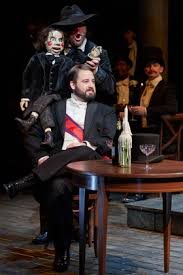By CB AdamsContributing Writer
In a cultural marketplace that is embracing new operatic
works such as “The Central Park Five” and “The Handmaid’s Tale,” is another
production of Verdi’s venerable chestnut Rigoletto really necessary – or
even relevant? Opera Theatre of Saint
Louis’ current production of Rigoletto provides a chorus of emphatic
yeses.
Although it can be asserted that the opera canon in general
and Rigoletto in particular is testosteroney (to borrow a line from
“Friends”), misogynistic and seemingly anachronistic in the current #MeToo
cultural climate, OTSL’s production brings to the fore the question, “Who is
the true victim of the machinations of the men in this play?”
The answer in this interpretation is clear: Rigoletto’s own daughter, Gilda. She has lived her short life cloistered in a tight ring of chastity, raised by an overly protective father (or hostage-taker, depending on your point of view), whose nickname is Transgression. She falls in first-love with the duplicitous Duke (dubbed Retribution), whom she meets at her seemingly only contact with the real world – Mass at the local church (another male-dominated institution). The poor girl. Given such options and opposing forces, it’s no wonder she believes self-destruction is the only way to escape this milieu of trickle-down masculinity.
Even before the orchestra tunes up, OTSL’s latest take on Rigoletto
begins to pull the audience members out of their comfort zone. Sitting on a
trunk, center stage in low light, is Rigoletto’s puppet, staring blankly like a
demented Charlie McCarthy dummy, a chubby-cheeked Chucky. He seems to be
saying, “Let the horror begin.”
This conceit by itself would not be enough to carry the
opera. The cast, under the stage direction of Bruno Ravella, who is making his
main season debut, is fully up to the challenge of Verdi’s memorable score and
this production’s challenging, polarizing balance. Roland Wood immerses himself
in the role of Rigoletto, the Duke’s own dummy, as a man resentfully balanced
(or unbalanced, depending on your point of view) between being a
father/manipulator and being manipulated as the Duke’s court jester. Wood effectively
leads the audience to ponder: “Should I blame you or pity you?”
As the Duke, Joshua Wheeker, is a selfish puppeteer
extraordinaire. He does not overplay the indulgent, king-baby aspects of the
role and instead offers a straightforward “what the Duke wants, the Duke gets”
attitude – and to hell with who pays consequences. His short-sighted need for
instant gratification enables the storylines of Rigoletto and Gilda to unravel.
In terms of relevance, this should be familiar to anyone who follows the
current news cycles.
Navigating (or trapped, depending on your point of view) between
a fiercely overprotective father and a hedonistic lover is the wonderful and
wonderfully cast So Young Park, a former Gerdine Young Artist. With seeming
effortlessness, Park wends through her a role that demands she be naïve without
being girlishly gushy (ala Liesl’s “Sixteen Going On Seventeen” in Sound of
Music). Young accomplishes this as well as meshes her performances
seamlessly with Wood, especially in Act II.
Among the supporting cast, Christian Zaremba, making his
Opera Theatre main season debut, plays Sparafucile, the assassin, with reserve
and respect – admirable considering how easy it would have been to overplay the
part with squinty sliminess. Zaremba’s straightforward, transactional portrayal
facilitates the opera rather than calls too much attention to the role. Also of
note is the horn-dog horde – the male chorus that moves about the opera en
masse, providing light humor, encouragement to the Duke’s predilections (as
only good sycophants can) and locker-room banter.
OTSL’s Rigoletto is set in Paris, where Victor Hugo
set his play, which is the source for this opera. The Francophile-inspired set
design, under the aegis of Alex Eales, is understated, streamlined and
efficiently conveys the essence of each scene. The opening scene keys off a
recognizable Folies Bergere atmosphere and the inn where Sparafucile and his
sister conspire to murder the Duke is distinctly saloon-like in a Wild West
sort of way. On the surface this may seem incongruent, but the sets well within
the opera’s polarizing elements. They provide “just enough” background for the
story.
Like the set design, costume design, by Mark Bouman, does
not break new ground, but neither does it break the flow of the entire opera.
Both serve well the story being told. In Act I’s party scene, the dresses of
the dancing ladies have a pleasing Manet, demimondaines quality. Sparafucile
sports a Driza-Bone-inspired duster that makes him instantly recognizable
regardless of the scene. And Gilda wears dresses – girlish without being girly
– that befit a young lady with a conservative father. Even Gilda’s final
costume, when she is posing as man, is Chaplinesque in a way that makes sense
within this production.
Rigoletto may be one of Verdi’s workhorse operas, but
like all great art, it is open to wide interpretation. Just as Paul Simon
observed that “every generation throws a hero up the pop charts,” every
generation since the premiere in 1851 has produced a Rigoletto befitting
its times. OTSL’s is exceptionally no exception. #GoSeeRigoletto.
“Rigoletto” plays at the Loretto-Hilton Center through June 30. For more information or to purchase tickets, visit www.experienceopera.org

Lynn (Zipfel) Venhaus has had a continuous byline in St. Louis metro region publications since 1978. She writes features and news for Belleville News-Democrat and contributes to St. Louis magazine and other publications.
She is a Rotten Tomatoes-approved film critic, currently reviews films for Webster-Kirkwood Times and KTRS Radio, covers entertainment for PopLifeSTL.com and co-hosts podcast PopLifeSTL.com…Presents.
She is a member of Critics Choice Association, where she serves on the women’s and marketing committees; Alliance of Women Film Journalists; and on the board of the St. Louis Film Critics Association. She is a founding and board member of the St. Louis Theater Circle.
She is retired from teaching journalism/media as an adjunct college instructor.

